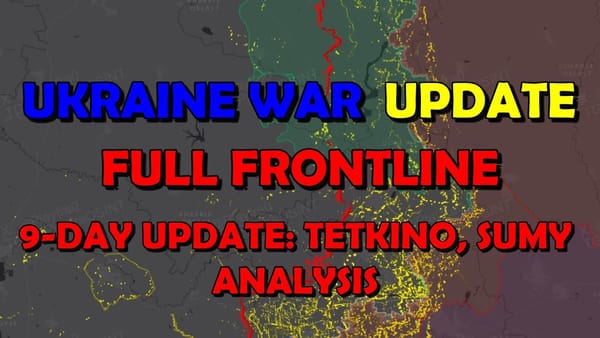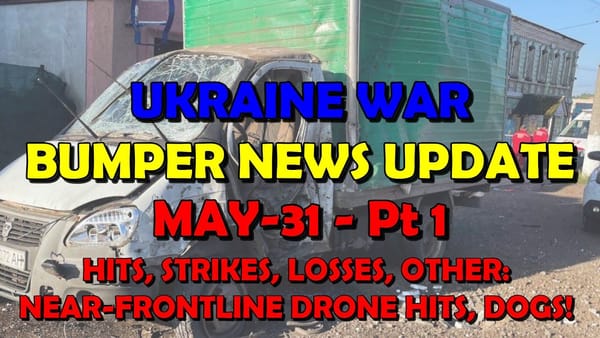Ukraine Conflict: Full Frontline Update
Table of Contents 📖
“I actually don't, as I said, don't think that they will or can [make a major breakthrough in the summer]. But let me know what you think with regard to all of those dynamics.”
Hello Team
🎦 00:00-00:14⏩
Jonathan welcomes viewers to another frontline update for 7th March 2024 and reminds viewers about the key for his map.
Return to top⤴️
📍 FRONT-LINE UPDATE -🗺️ MAP LEGEND

Kupyansk-Svatove Front
🎦 00:14-04:45⏩
Jonathan starts with the Krynky area in the south of the Kupyansk-Svatove front, noting that there has been very little movement before moving north to the Kupyansk-Svatove-Kreminna line. He highlights differences between the maps produced by Andrew Perpetua, Deep State Map and Suriat Maps, and notes that, according to Andrew Perpetua's map, the Russians have made small gains north of Lyman Persha. Jonathan questions why there are still grey areas on the Ukrainian side of the Oskil River and comments that he is amazed that the Russians have not pushed the Ukrainians back to the river. Whilst this area of the river is difficult to cross due to the bluffs, it is easier further north where the settlements are located on the river’s edge. Jonathan believes it likely that the Russians will attempt to make gains in this area in the future. Jonathan reports that, according to Minako Kivoblast, the military administration head, 100,000 Russian personnel (40,000 of whom are combat personnel) are massed in the Kupyansk-Lyman directions and comments that this number has been reported many times before. He suggests that the figure of 40,000 combat personnel may include recently mobilised troops who are not yet combat-ready but who could be moved further down the frontline to make up for Russian losses. Jonathan concludes that it is therefore difficult to know what to make of these figures.
Return to top⤴️
Bakhmut Front
🎦 04:47-05:04⏩
Jonathan reports that there has been no movement on the Bakhmut front today.
Return to top⤴️
Avdiivka-Donetsk City Front
🎦 05:04-11:45⏩
Jonathan begins by noting that, after a couple of days of stasis, there has been a little movement north of Berdychi, with Andrew Perpetua's map aligning more closely with the other two maps, although all three maps still show Berdychi as being, at least in part, under Ukrainian control. He notes that Suriat Maps claims that the Russians control most of Olivka, whilst Deep State Map shows them in control of half and Andrew Perpetua shows no Russian control. Jonathan believes it is probably a grey zone but acknowledges that the Russians appear to have pushed up to the river (according to Deep State Map and Suriat Maps) and describes this is significant, as this is where the Ukrainian defensive line is. However, the higher ground is all on the Ukrainian side of this river, which the Russians would find difficult to cross with their equipment. It remains to be seen what will happen if the Russians do manage to get across the river. A Russian milblogger has claimed that Russian forces now control half of Tonenke and Pervomaiske and most of Olivka. Jonathan compares this to the other maps and explains that only Suriat Maps shows Russian control of half of Tonenke. In terms of Pervomaiske, the Russians appear to be advancing slowly up through the village and, according to Suriat Maps, are also having some success around the reservoir to the east. Another milblogger claimed that the Russians control the eastern half of Berdychi (which is in line with Suriat Maps), whilst another has complained about Russian electronic warfare systems interfering with drone operations near Lastochkyne. The same milblogger also claimed that Russian assaults west of Avdiivka have slowed, with the Ukrainians consolidating on new defensive lines and that the increasing degradation of Russian forces in the area is exposing issues with planning and coordination between their military command and frontline units. This is supported by the Ukrainian Tavris Group of Forces Press Service, who reported that Ukrainian forces have now established a second line of defensive fortifications in the Avdiivka direction, which are equipped with asphalt support points (to provide higher and more secure trench walls), anti-tank trenches, concrete bunkers and dragon's teeth. Unspecified protection against shelling and drone strikes is also in place. Jonathan notes that this indicates that the Ukrainians are improving their defensive positions, after questions about why this had taken so long. It is possible that they have now reached the point where they can successfully resist Russian advances. Jonathan concludes this section by observing that the pace of Russian advances has definitely slowed down, although some small gains are still being made.
Return to top⤴️
Mariinka Front
🎦 10:16-11:45⏩
Jonathan observes that, according to Andrew Perpetua’s map, there have been some slight changes around Mariinka, with the Ukrainians appearing to have made some gains in the tree lines, pushing the Russians back north of Mariinka around Krasnohorivka. However, it is more likely that Andrew Perpetua is aligning his map with Deep State Map and Suriat Maps, both of which show greater Russian control to the west of Mariinka. Jonathan explains that, according to the Institute for the Study of War (ISW), Russian forces have also made marginal advances in Heorhiivka, based on geolocated footage published on 6th March.
Return to top⤴️
Velyka Novosilka - Hulyapole Front
🎦 11:45-13:17⏩
Jonathan explains that, whilst there are no changes to report from Velyka Novosilka or Huliaipole, there have been claims from Suriat Maps that Russian forces have made significant gains in the Robotyne area, west of Novoprokopivka and have taken back the last section of the ‘Surovikin fortifications’ that was still under Ukrainian control. However, whilst there is geolocated evidence to suggest that the Russians have advanced as far west as shown on Suriat Maps, the geolocated footage of Russian infantry being hit by Ukrainian FPV drones suggests that this is more likely to be a grey zone. Jonathan explains that Andrew Perpetua is reluctant to make changes to his map based on evidence such as this, as it does not prove that the Russians have consolidated their positions or are able to hold the area.
Return to top⤴️
Southern Front
🎦 13:17-13:41⏩
Jonathan reports that there is little to report from the southern front, other than that there are ongoing, although limited, engagements in the Kherson area.
Return to top⤴️
Macron’s Response to the War in Ukraine
🎦 13:41-29:05⏩
Jonathan introduces this section by reporting that French President Emmanuel Macron has been positioning himself as something of a rallying leader in Europe. Jonathan believes that this is essential, as Europe is finally waking up to the threat posed by Russia. Macron has been trying to impress upon the French people, French political leaders and European leaders the seriousness of the situation, recently holding a video conference (also attended by Moldovan leaders) to discuss how support for both Ukraine and Moldova can be strengthened. Jonathan highlights a recent article in Le Monde, which reported that Macron hopes to convince the French population of the seriousness of the situation. In response to Macron’s more assertive stance (which has included questioning whether there should be any ‘red lines’ in terms of support for Ukraine), Russian Prime Minister Dmitry Medvedev warned that Russia would also no longer have any ‘red lines’ in relation to France. Jonathan notes that this is typical of Russia’s approach, which involves a great deal of rhetoric and threats that rarely, if ever, come to anything. Jonathan goes on to quote security expert Shashank Joshi who questioned what French military intelligence is telling Macron to make him believe that this escalation is necessary. Joshi notes that, whilst Western officials have previously downplayed the potential for a Russian breakthrough (citing limitations in ammunition and leadership), experts have been more cautious and have pointed to weaknesses in Ukraine’s defences. Jonathan explains that, whilst he understands the concerns about the size of the force amassed by the Russians in Luhansk Oblast and their advances in Avdiivka, Novomykolaivka and Mariinka, he believes that Russia has very little in reserve. However, he concedes that they appear to be able to keep pushing, despite throwing poorly trained and equipped troops at the Ukrainians and that, combined with the ongoing issues with military aid to Ukraine, this is pushing Ukraine to its knees. He acknowledges that, whilst his view may be unpopular, he believes that both sides are on their knees. Jonathan argues that this realisation is what has driven Olaf Scholz to step up Germany’s support, despite the ongoing issues around the supply of Taurus missiles, and has led to Macron taking on a more prominent role. He believes that more countries, including the UK, could and should be doing more, pointing out that, contrary to popular opinion (and despite the UK’s provision of Storm Shadow missiles and Challenger 2 tanks), the UK’s contribution to Ukraine’s defence in terms of a percentage of GDP is actually much lower than many other European nations. To illustrate his point about the UK’s priorities, Jonathan explains that, in an attempt to shore up support for the Conservative Party, the UK government have just announced a budget that will see them give away £14 billion that they do not need to spend. Jonathan is angered by this as he feels that this money could have been far better spent supporting UK defence manufacturers, bolstering the UK’s own armed forces and/or providing additional equipment to Ukraine. He is amused to note that even the Daily Telegraph, which is usually very pro-UK government and highly critical of the EU, was forced to admit that, of the 10 countries (including the UK) whose contributions towards Ukrainian defence they had analysed, the UK came bottom. To return to Macron, Joshi reports that he recently invited the leaders of all the French parliamentary parties to the Elysee Palace to explain the thinking behind his recent remarks about the possibility of sending Western troops to Ukraine. His aim, it seems, is to keep Russia guessing. However, whilst Joshi acknowledges that this strategy of strategic ambiguity makes sense (given that Russia appears to be operating without limits), opposition politicians from both the left and the far right (including Marine Le Pen) remain unconvinced. Macron’s stance has also been rejected by the US, the UK, Germany and several other NATO countries. Unsurprisingly, Marine Le Pen’s Rassemblement National party (which has well-documented links to Russia) dismissed Macron’s suggestion of sending French troops to Ukraine as irresponsible and dangerous. Macron, for his part, is apparently hoping that his new rhetoric will expose Le Pen and highlight her long history of supporting Putin. Government spokespeople were also quick to point out that Le Pen is not committed to Russia’s defeat. Jonathan concludes by explaining that the key takeaway from Macron’s behaviour is that French intelligence sources appear to be suggesting that Ukraine is struggling and that there is a real possibility of Russia achieving a major breakthrough this summer. He acknowledges that he does not share this opinion but is interested to hear the views of his followers.
Return to top⤴️
Wrap Up
🎦 29:05-29:11⏩
Jonathan thanks his viewers and signs off.
Return to top⤴️



